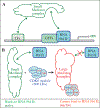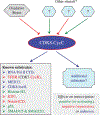Dysregulation of CDK8 and Cyclin C in tumorigenesis
- PMID: 22035865
- PMCID: PMC9792140
- DOI: 10.1016/j.jgg.2011.09.002
Dysregulation of CDK8 and Cyclin C in tumorigenesis
Abstract
Appropriately controlled gene expression is fundamental for normal growth and survival of all living organisms. In eukaryotes, the transcription of protein-coding mRNAs is dependent on RNA polymerase II (Pol II). The multi-subunit transcription cofactor Mediator complex is proposed to regulate most, if not all, of the Pol II-dependent transcription. Here we focus our discussion on two subunits of the Mediator complex, cyclin-dependent kinase 8 (CDK8) and its regulatory partner Cyclin C (CycC), because they are either mutated or amplified in a variety of human cancers. CDK8 functions as an oncoprotein in melanoma and colorectal cancers, thus there are considerable interests in developing drugs specifically targeting the CDK8 kinase activity. However, to evaluate the feasibility of targeting CDK8 for cancer therapy and to understand how their dysregulation contributes to tumorigenesis, it is essential to elucidate the in vivo function and regulation of CDK8-CycC, which are still poorly understood in multi-cellular organisms. We summarize the evidence linking their dysregulation to various cancers and present our bioinformatics and computational analyses on the structure and evolution of CDK8. We also discuss the implications of these observations in tumorigenesis. Because most of the Mediator subunits, including CDK8 and CycC, are highly conserved during eukaryotic evolution, we expect that investigations using model organisms such as Drosophila will provide important insights into the function and regulation of CDK8 and CycC in different cellular and developmental contexts.
Copyright © 2011. Published by Elsevier Ltd.
Figures






References
-
- Akoulitchev S, Chuikov S, Reinberg D, 2000. TFIIH is negatively regulated by cdk8-containing mediator complexes. Nature 407, 102–106. - PubMed
-
- Barette C, Jariel-Encontre I, Piechaczyk M, Piette J, 2001. Human cyclin C protein is stabilized by its associated kinase cdk8, independently of its catalytic activity. Oncogene 20, 551–562. - PubMed
-
- Bjorklund S, Gustafsson CM, 2005. The yeast Mediator complex and its regulation. Trends Biochem. Sci 30, 240–244. - PubMed
Publication types
MeSH terms
Substances
Grants and funding
LinkOut - more resources
Full Text Sources
Other Literature Sources
Molecular Biology Databases

